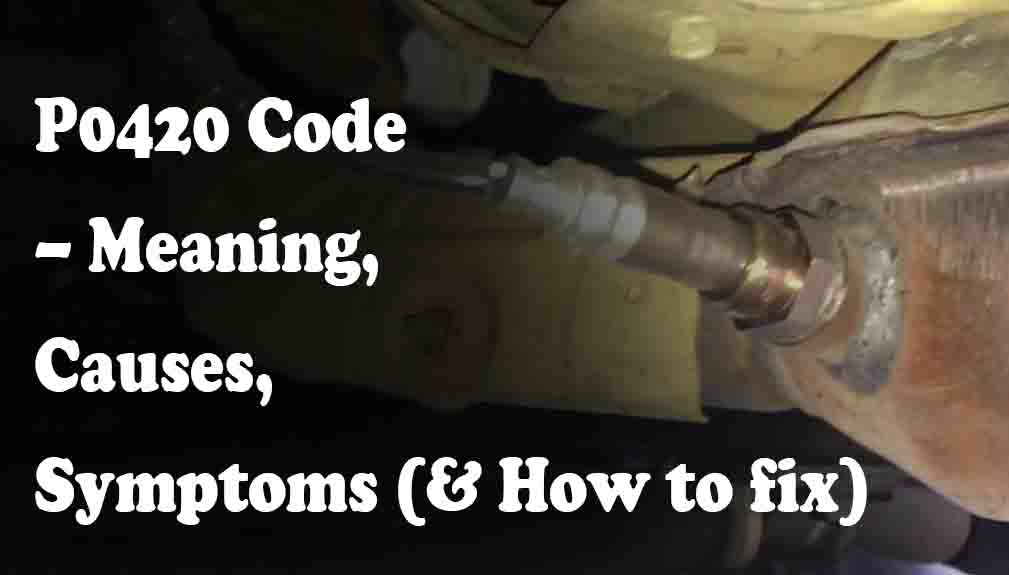P0420 is one of the most common error codes. This guide applies to most vehicles and explains what the code means, what causes it, and how to fix it. “P0420” is a code used by the automotive industry, which means the vehicle may have some sort of problem that needs to be taken care of.
Hopefully, this article will explain what this error code means, what may be causing it and how to fix it. It’s not the first time that this particular code comes up but I have fixed it in the past by just replacing the part with one that is free but doesn’t appear as often. Unfortunately, when we looked for the replacement part this time, we weren’t able to find one.
In this blog post, we’ll answer all your questions about Amazon’s E-Commerce business. You’ll get a quick summary of the P0420 code. You’ll also learn what the P0420 code means, as well as when you should see a technician to fix the P0420 code.
Table of Contents
Code Definition
P0420 – Catalyst System Efficiency Below Threshold (Bank 1)
What does the P0420 Code Mean?
The P0420 code indicates that the ECM has detected underperformance of the catalytic converter’s efficiency on Bank 1. Either it is a faulty catalytic converter, or it could be an electronic oxygen sensor.
The ECM uses two O2 sensors to detect whether the catalytic converter is functioning properly, whether there is a problem with the fuel mixture, or if there is.

If the P0420 code is triggered, the Catalyst system’s efficiency is low. A P0420 trouble code is usually due to a bad catalytic converter. If the catalytic converter does not contain the correct amount of air, fuel, and oil, it will have to undergo repair or replacement.
What are some possible causes of a P0420?
The most common cause of the P0420 code is a faulty catalytic converter. Most of these problems are caused by a faulty oxygen sensor, exhaust system leak, intake leak, or an improperly installed catalytic converter.
It’s more than likely a defective catalyst. It can be either a defective original part or a substitute. A less expensive catalyst may not have the strength required to cleanse your hair well. This could result in you needing to buy a new catalyst from the manufacturer.
I’ve also seen aftermarket cat converters that were installed too far away from the engine on the exhaust pipe. This could cause the vehicle to shut off as a safety precaution, since the catalytic converter isn’t getting hot enough to properly operate. If the engine’s air-fuel mixture is incorrect due to a faulty injector, high fuel pressure, faulty fuel system, or a damaged sensor, it may cause the catalytic converter to not function properly.
The main causes of the P0420 code include:
These are the most common causes of engine code P0330: Faulty or missing catalytic converter. It is most commonly caused by a damaged or missing catalytic converter, incorrect placement, oil contamination in the catalytic converter, incorrect fuel type, and rich/lean mixtures.
What repairs can fix the P0420 code?
You should first check the function of the catalytic converter with the methods further down in the article. Then you should replace any damaged parts.
The error message on your laptop screen might be misleading. It could mean several things, so the first thing to do is to make a proper diagnosis. Here are some things that could fix your error:
You need to replace your exhaust system and repair any damaged sensors. Fix high oil consumption and fix misfires. Replace catalytic converter, replace front or rear oxygen sensor, and replace any damaged sensor wiring. If your engine is performing poorly, check out this book for your replacement needs.
What are the signs of a P0420 code?
A Code P0420 is most often caused by an issue with your car’s fuel pump. It’s easy to detect and fix. Check your fuel pump for signs of damage and then have it repaired or replaced.
The most common problems you’ll face with your vehicle are ignition misfires, a higher fuel consumption, and a bad odor from the exhaust pipe.
A check engine light with the P0420 code can usually be seen on your dashboard. You may also see the light on the steering column, in the passenger side front fender, or in the center console.
How serious is the P0420 code?
The code will likely not cause further problems with your car’s engine.Q:
The only thing that could potentially happen is that the catalytic converter is so damaged that its internal parts fall off, which is unlikely to happen though.
If the P0420 trouble code results in worse emissions from your car, that’s bad for the environment, so you should try to fix it as soon as possible.
What are the common P0420 diagnosis mistakes?
The most common mistake is replacing the oxygen sensors before you diagnose them properly. The reason why you see an engine code on your car is normally the catalytic converter – which may get damaged by other issues in your car’s engine like misfires or a rich or lean air-fuel ratio.
Scan your diagnostic scanner for any other trouble codes, too. If you find codes like P0309, P0310, P0311, P0312, P0313, P0314, P0315, P03. If this happens, check all the wiring on the vehicle to make sure that there are no loose or disconnected cables.
If you find the DTC codes P0207 or P0208 it means your fuel system may need to be replaced. One possible reason why your vehicle may not accelerate as fast as usual could be a faulty sensor that measures engine coolant temperature. There are two ways to address the air-fuel mixture. See if the code P0420 comes back after addressing each one of them.
You may have to use a catalytic converter cleaner before replacing your catalytic converter if there are no other problems with your engine.
There are a lot of different additives on the market, and we recommend one of the best catalytic cleaners from our list.
Common P0420 Code Causes by Car Model
Some models have more problems than others, and some are much more common than others.
These cars have a problem with this diagnostic trouble code. A list of the most common causes by car brands is below. You can use these guidelines as a starting point for making a diagnosis, and then replace the parts as needed.
1. Chevrolet
If you have a p0420 code on your Chevy it may be due to an exhaust leak before the catalytic converter.
The exhaust system on your vehicle may have cracked or worn out over time. This could cause carbon monoxide to enter the car’s cabin. The Chevy engine’s are known to leak around the exhaust manifold, so you should check that.
2. Toyota & Nissan
It’s the most common cause of P0420 in Toyota and Nissan cars. You may ensure your engine is not burning engine oil.
First check for vacuum and exhaust leaks, because you never know when something might happen. Check to see if you notice any blue smoke coming from the exhaust pipe.
If you feel like your car is lacking in power, it’s likely because of a faulty engine or maybe even something as simple as bad piston rings. If you don’t notice any blue smoke, it’s most likely your catalytic converter needs to be replaced. There are many similar issues on Nissan cars.
2. Ford
The most common issues on a Ford engine are vacuum leaks and a broken EGR (exhaust gas recirculation) solenoid.
Your check the engine light is on, there’s a check engine light. Run a diagnostic check with a diagnostic scanner to see what might be wrong with your air-fuel mixture.
When everything looks fine, check for exhaust leaks. You can diagnose and replace the catalytic converter if you can’t find any trouble codes or other problems with the air-fuel mixture.
3. Subaru & Honda
If you see the P0420 error code in your vehicle, it’s most likely the catalytic converter causing the issue. A defective exhaust pipe can cause the check engine light to come on, and it may also need replacing.
See if your vehicle has vacuum leak problems or other fuel mixture related engine code trouble codes. Check for any exhaust leaks before the catalytic converter. Subaru’s boxer engine design is not the most popular type of engine, but the most common problem with Subaru engines is the catalytic converter.
4. Volkswagen (VW) / Skoda / Seat / Audi A4 1.8T / V6 2.4
Most VAG cars experience one or more of these problems causing the P0420 code.
Check the check valves’ function under the intake and make sure the crankcase ventilation is free of dirt, causing the engine to burn oil, which clogs the catalytic converter.
Inspect the exhaust system for leaks around the exhaust pipes, and check for any engine codes related to the oxygen sensors. If the air filter is new, replace the catalytic converter. It’s a problem with the 1.8T and the V6 petrol engine.
How do you diagnose the P0420 code?
This code indicates that the computer’s motherboard may be malfunctioning. It is good to diagnose your car by checking its battery, oil, tire pressure, and transmission fluid levels.
This handy OBD II scanner can be connected to your vehicle’s computer diagnostic system to display the trouble codes, which can then be viewed to identify any problems Repair the trouble codes related to the ignition or fuel. See the live data to see the front and read the O2 sensor voltage signals.
1.You need to make sure that your sensor range is steady at
2.2 volts. If it’s higher than
If you get similar readings, there is a chance that the catalytic converter is defective. Check the temperature of the front of the catalytic converter and then the rear with a laser thermometer.
The cat is hot and there is no difference in temperature before and after the catalytic converter – your catalytic converter may not work as intended. If the catalytic converter is installed reachable, it may be worth checking it for damage. It could be worth removing the pipe from one end of it and looking inside for visual damage. If everything points at a faulty catalytic converter – replace it.
If the machine doesn’t start up, turn it off and then wait for the power supply to cool down. If that doesn’t work, try to inspect the machine for physical damage. If you’re still not able to locate any problems. This could mean that the problem is with the system or your vehicle. Either way, you need to contact a mechanic immediately. If everything seems fine – replace the catalytic converter.
How much does DTC P0420 repair cost?
There’s no fixed cost to fix the P0420 code, as it could be caused by many different factors. This problem may be caused by a faulty catalytic converter that can usually cost about 500$ to 1500$.
How much it would cost to fix your code is $30,000.
The price includes the cost of parts and labor to make your watch. Diagnosis costs may include an emissions test to measure the accuracy of your catalytic converter, a fuel system flush to remove contaminants and a filter replacement, depending on how many times your vehicle has been serviced.
